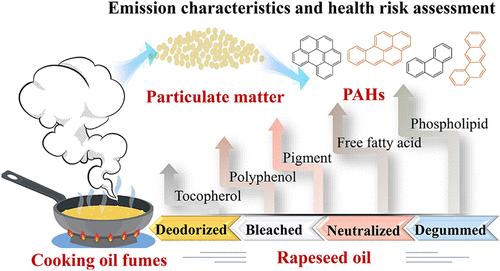当前位置:
X-MOL 学术
›
J. Agric. Food Chem.
›
论文详情
Our official English website, www.x-mol.net, welcomes your
feedback! (Note: you will need to create a separate account there.)
Particulate Matter and Associated PAHs within the Fumes Emitted from Heat-Cooking Rapeseed Oils: Focus on the Refining Level and Trace Components of Rapeseed Oil
Journal of Agricultural and Food Chemistry ( IF 5.7 ) Pub Date : 2025-06-04 , DOI: 10.1021/acs.jafc.5c03100
Yaping Lv, Yuanyi Xiong, Shufan Luo, Zhan Ye, Yuanfa Liu
Journal of Agricultural and Food Chemistry ( IF 5.7 ) Pub Date : 2025-06-04 , DOI: 10.1021/acs.jafc.5c03100
Yaping Lv, Yuanyi Xiong, Shufan Luo, Zhan Ye, Yuanfa Liu

|
The refining process can improve the edible oil’s smoke point and reduce the heat-cooking fume emissions. However, the influence of temperature, refining level, and trace components within rapeseed oil on particulate matter (PM) and its associated polycyclic aromatic hydrocarbons (PPAHs) in the heat-cooking fumes remains unclear. Herein, the effects of the refining degree and trace components of rapeseed oil on PM and PPAHs in heat-cooking fumes were analyzed. Results revealed that increasing the final heating temperature of the rapeseed oil from 160 to 280 °C resulted in 10 times rise in PM emissions and 12.7 times increase in PPAH concentrations. All refining processes except bleaching can reduce PM emissions from heated crude oil, with the degumming process being the most effective. Moreover, the concentration and carcinogenic risk of PPAHs were mainly reduced by deodorization. The influences of trace components on the PM and PPAH concentrations were further explored by adding oleic acid, phosphatidylcholine, β-carotene, canolol, chlorophyll, and γ-tocopherol into the refined rapeseed oil. Phosphatidylcholine and oleic acid were found to increase PM concentrations in heat-cooking oil fumes, whereas canolol can reduce PM levels by 51.3%. For PPAHs, oleic acid can increase the concentration of PPAHs in cooking oil fumes, whereas γ-tocopherol, canolol, β-carotene, and chlorophyll can decrease it. Additionally, phosphatidylcholine can significantly increase the concentration of benzo[a]pyrene, which in turn increases its carcinogenic risk by 10.1 times. The present work provided a theoretical basis for controlling the formation of harmful components in heat-cooking fumes from the perspective of edible oil.
中文翻译:

热蒸煮菜籽油排放的烟雾中的颗粒物和相关多环芳烃:关注菜籽油的精炼水平和微量成分
精炼过程可以提高食用油的烟点并减少热烹饪油烟的排放。然而,温度、精炼水平和菜籽油中的痕量成分对热烹饪油烟中颗粒物 (PM) 及其相关的多环芳烃 (PPAH) 的影响仍不清楚。本文分析了菜籽油的精炼程度和微量成分对热蒸煮油烟中 PM 和 PPAHs 的影响。结果显示,将菜籽油的最终加热温度从 160 °C 提高到 280 °C 导致 PM 排放量增加 10 倍,PPAH 浓度增加 12.7 倍。除漂白外,所有精炼工艺都可以减少加热原油的 PM 排放,其中脱胶工艺是最有效的。此外,PPAHs 的浓度和致癌风险主要通过除臭来降低。通过在精制菜籽油中加入油酸、磷脂酰胆碱、β-胡萝卜素、药洛尔、叶绿素和 γ-生育酚,进一步探究痕量成分对 PM 和 PPAH 浓度的影响。研究发现磷脂酰胆碱和油酸可增加热食油烟雾中的 PM 浓度,而 Canolol 可将 PM 水平降低 51.3%。对于 PPAHs,油酸可以增加食用油烟气中 PPAH 的浓度,而 γ-生育酚、芹酚、β-胡萝卜素和叶绿素可以降低 PPAH 的浓度。此外,磷脂酰胆碱可显著提高苯并[a]芘的浓度,进而使其致癌风险增加 10.1 倍。本研究为从食用油角度控制热蒸煮油烟中有害成分的形成提供了理论依据。
更新日期:2025-06-04
中文翻译:

热蒸煮菜籽油排放的烟雾中的颗粒物和相关多环芳烃:关注菜籽油的精炼水平和微量成分
精炼过程可以提高食用油的烟点并减少热烹饪油烟的排放。然而,温度、精炼水平和菜籽油中的痕量成分对热烹饪油烟中颗粒物 (PM) 及其相关的多环芳烃 (PPAH) 的影响仍不清楚。本文分析了菜籽油的精炼程度和微量成分对热蒸煮油烟中 PM 和 PPAHs 的影响。结果显示,将菜籽油的最终加热温度从 160 °C 提高到 280 °C 导致 PM 排放量增加 10 倍,PPAH 浓度增加 12.7 倍。除漂白外,所有精炼工艺都可以减少加热原油的 PM 排放,其中脱胶工艺是最有效的。此外,PPAHs 的浓度和致癌风险主要通过除臭来降低。通过在精制菜籽油中加入油酸、磷脂酰胆碱、β-胡萝卜素、药洛尔、叶绿素和 γ-生育酚,进一步探究痕量成分对 PM 和 PPAH 浓度的影响。研究发现磷脂酰胆碱和油酸可增加热食油烟雾中的 PM 浓度,而 Canolol 可将 PM 水平降低 51.3%。对于 PPAHs,油酸可以增加食用油烟气中 PPAH 的浓度,而 γ-生育酚、芹酚、β-胡萝卜素和叶绿素可以降低 PPAH 的浓度。此外,磷脂酰胆碱可显著提高苯并[a]芘的浓度,进而使其致癌风险增加 10.1 倍。本研究为从食用油角度控制热蒸煮油烟中有害成分的形成提供了理论依据。


















































 京公网安备 11010802027423号
京公网安备 11010802027423号